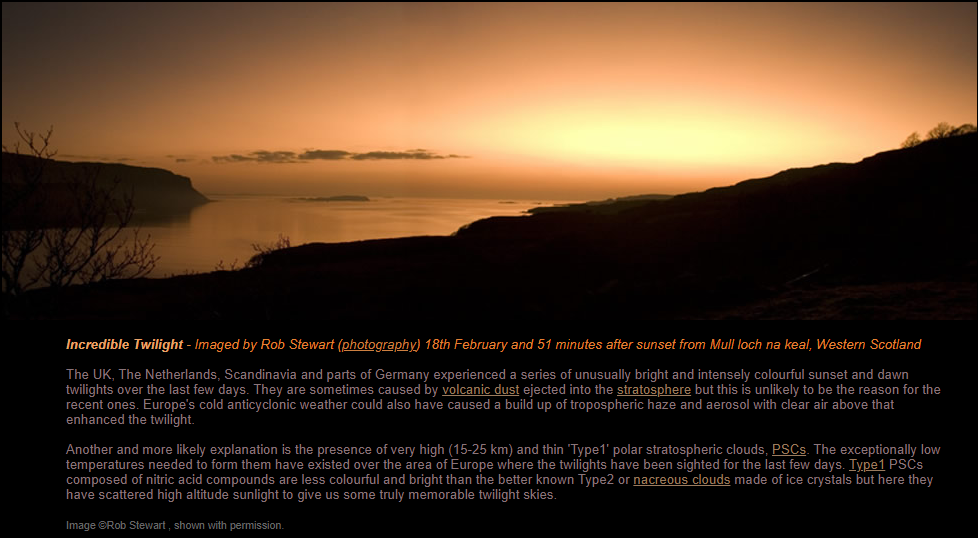Today's Feature Incredible Twilights
Today's Feature: Incredible Twilights
Over the last few days, the UK, The Netherlands, Scandinavia, and parts of Germany have been treated to a series of stunning and vibrant sunset and dawn twilights. These incredible displays of color and brightness have captivated observers, leaving them in awe of the beauty of the sky. While such phenomena are often attributed to volcanic dust in the stratosphere, this is unlikely to be the cause for the recent occurrences. Instead, there are a few other explanations that shed light on these breathtaking twilights.
One possible reason for these extraordinary twilights is the presence of very high and thin 'Type1' polar stratospheric clouds (PSCs) at altitudes of 15-25 km. These clouds, composed of nitric acid compounds, are less colorful and bright compared to the more well-known Type2 or nacreous clouds made of ice crystals. However, in this case, they have played a significant role in scattering high altitude sunlight and creating truly unforgettable twilight skies.
The formation of Type1 PSCs requires exceptionally low temperatures, which have been prevalent over the European region where these twilights have been observed. The cold anticyclonic weather conditions in Europe may have contributed to a build-up of tropospheric haze and aerosols, with clear air above that acted as a canvas for the scattered sunlight to interact with the Type1 PSCs. This combination of factors has resulted in the mesmerizing hues and intensity witnessed during these twilights.
While volcanic dust is typically associated with such atmospheric optical phenomena, it is important to note that its influence is not the primary cause in this instance. The absence of volcanic activity during this period suggests that other factors are at play. By exploring alternative explanations, we gain a deeper understanding of the complex interplay between atmospheric conditions and the visual spectacle we observe in the sky.
The recent twilights have left both scientists and the general public intrigued, as they deviate from the more commonly observed atmospheric optical phenomena. By studying these unique occurrences, researchers can expand their knowledge of atmospheric dynamics and improve their ability to predict and explain similar events in the future. Each extraordinary twilight serves as a reminder of the vastness and complexity of our atmosphere, and the wonders it can unveil.
It is worth noting that the original content was automatically converted from the old site and may not appear as intended. However, the essence of the article remains intact, allowing us to delve into the fascinating topic of incredible twilights. These occurrences serve as a testament to the beauty and diversity of our natural world, providing a visual feast for those fortunate enough to witness them.
In conclusion, the recent series of incredible twilights in Europe have sparked curiosity and wonder among observers. While volcanic dust is often associated with such phenomena, it is unlikely to be the cause in this case. Instead, the presence of Type1 polar stratospheric clouds, combined with cold anticyclonic weather conditions and atmospheric aerosols, has contributed to the breathtaking colors and brightness witnessed during these twilights. By studying and understanding these occurrences, we gain valuable insights into the intricate workings of our atmosphere and the awe-inspiring spectacles it can produce.

Incredible Twilight - Imaged by Rob Stewart (photography) 18th February and 51 minutes after sunset from Mull loch na keal, Western Scotland
The UK, The Netherlands, Scandinavia and parts of Germany experienced a series of unusually bright and intensely colourful sunset and dawn twilights over the last few days. They are sometimes caused by volcanic dust ejected into the stratosphere but this is unlikely to be the reason for the recent ones. Europe's cold anticyclonic weather could also have caused a build up of tropospheric haze and aerosol with clear air above that enhanced the twilight.
Another and more likely explanation is the presence of very high (15-25 km) and thin 'Type1' polar stratospheric clouds, PSCs. The exceptionally low temperatures needed to form them have existed over the area of Europe where the twilights have been sighted for the last few days. Type1 PSCs composed of nitric acid compounds are less colourful and bright than the better known Type2 or nacreous clouds made of ice crystals but here they have scattered high altitude sunlight to give us some truly memorable twilight skies.
Image ©Rob Stewart , shown with permission.
Note: this article has been automatically converted from the old site and may not appear as intended. You can find the original article here.
Reference Atmospheric Optics
If you use any of the definitions, information, or data presented on Atmospheric Optics, please copy the link or reference below to properly credit us as the reference source. Thank you!
-
<a href="https://atoptics.co.uk/blog/todays-feature-incredible-twilights/">Today's Feature Incredible Twilights</a>
-
"Today's Feature Incredible Twilights". Atmospheric Optics. Accessed on December 23, 2024. https://atoptics.co.uk/blog/todays-feature-incredible-twilights/.
-
"Today's Feature Incredible Twilights". Atmospheric Optics, https://atoptics.co.uk/blog/todays-feature-incredible-twilights/. Accessed 23 December, 2024
-
Today's Feature Incredible Twilights. Atmospheric Optics. Retrieved from https://atoptics.co.uk/blog/todays-feature-incredible-twilights/.